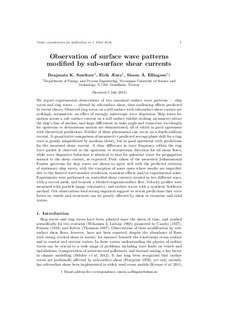| dc.contributor.author | Smeltzer, Benjamin Keeler | |
| dc.contributor.author | Æsøy, Eirik | |
| dc.contributor.author | Ellingsen, Simen Andreas Ådnøy | |
| dc.date.accessioned | 2019-07-05T11:36:23Z | |
| dc.date.available | 2019-07-05T11:36:23Z | |
| dc.date.created | 2019-07-02T10:12:25Z | |
| dc.date.issued | 2019 | |
| dc.identifier.citation | Journal of Fluid Mechanics. 2019, 873 508-530. | nb_NO |
| dc.identifier.issn | 0022-1120 | |
| dc.identifier.uri | http://hdl.handle.net/11250/2603638 | |
| dc.description.abstract | We report experimental observations of two canonical surface wave patterns – ship waves and ring waves – skewed by sub-surface shear, thus confirming effects predicted by recent theory. Observed ring waves on a still surface with sub-surface shear current are strikingly asymmetric, an effect of strongly anisotropic wave dispersion. Ship waves for motion across a sub-surface current on a still surface exhibit striking asymmetry about the ship’s line of motion, and large differences in transverse wavelength for upstream versus downstream motion are demonstrated, all of which is in good agreement with theoretical predictions. Neither of these phenomena can occur on a depth-uniform current. A quantitative comparison of measured versus predicted average phase shift for a ring wave is grossly mispredicted by no-shear theory, but in good agreement with predictions for the measured shear current. A clear difference in wave frequency within the ring wave packet is observed in the upstream versus downstream direction for all shear flows, while wave dispersive behaviour is identical to that for quiescent water for propagation normal to the shear current, as expected. Peak values of the measured two-dimensional Fourier spectrum for ship waves are shown to agree well with the predicted criterion of stationary ship waves, with the exception of some cases where results are imperfect due to the limited wavenumber resolution, transient effects and/or experimental noise. Experiments were performed on controlled shear currents created in two different ways, with a curved mesh and beneath a blocked stagnant-surface flow. Velocity profiles were measured with particle image velocimetry, and surface waves with a synthetic schlieren method. Our observations lend strong empirical support to recent predictions that wave forces on vessels and structures can be greatly affected by shear in estuarine and tidal waters. | nb_NO |
| dc.language.iso | eng | nb_NO |
| dc.publisher | Oxford University Press | nb_NO |
| dc.title | Observation of surface wave patterns modified by sub-surface shear currents | nb_NO |
| dc.type | Journal article | nb_NO |
| dc.type | Peer reviewed | nb_NO |
| dc.description.version | acceptedVersion | nb_NO |
| dc.source.pagenumber | 508-530 | nb_NO |
| dc.source.volume | 873 | nb_NO |
| dc.source.journal | Journal of Fluid Mechanics | nb_NO |
| dc.identifier.doi | 10.1017/jfm.2019.424 | |
| dc.identifier.cristin | 1709228 | |
| dc.description.localcode | This is a pre-copyedited, author-produced version of an article accepted for publication in [Journal of Fluid Mechanics ] following peer review. The version of record is available online at: https://doi.org/10.1017/jfm.2019.424 | nb_NO |
| cristin.unitcode | 194,64,25,0 | |
| cristin.unitname | Institutt for energi- og prosessteknikk | |
| cristin.ispublished | true | |
| cristin.fulltext | postprint | |
| cristin.qualitycode | 2 | |
